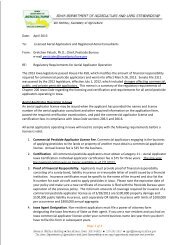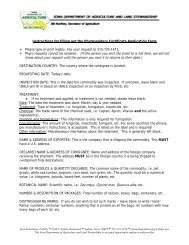Exhibit C: Detailed Background, Work Group Recommendations
Exhibit C: Detailed Background, Work Group Recommendations
Exhibit C: Detailed Background, Work Group Recommendations
You also want an ePaper? Increase the reach of your titles
YUMPU automatically turns print PDFs into web optimized ePapers that Google loves.
about potential flood mitigation from upland structures. He referenced the concept of<br />
“distributed storage,” which involves many small water storage structures instead of a large<br />
reservoir. To be viable, the system must be controllable – an active system. Multiple<br />
objectives direct the “best” decisions on activating the system – generating the question of<br />
who decides? The entire drainage network in a watershed, including both rivers and<br />
streams, is key. The City of Palo is considering distributed storage. Water in their basin<br />
travels about three miles per hour. Flooding is a confluence issue. Sometimes a “traffic jam”<br />
occurs in a drainage system, and that’s exactly what caused the 2008 Cedar Rapids flood<br />
when a storm dropped water on top of an already filled system.<br />
Paul Assman, Crawford County Engineer, said that holding even some water provides some<br />
benefit. This was proven with the retention structures in Crawford County that prevented<br />
flooding in 1993. The construction cost was covered as follows: state 75%, county 12.5%,<br />
city 2.5%, landowner 10%.<br />
Larry Weber from the U of I said that 500,000+ acre feet of storage would be needed to<br />
have protected Cedar Rapids from the 2008 flood, based on a recent study.<br />
John Goode, Monroe County Engineer, said four counties (Appanoose, Wapello, Monroe<br />
and Davis) are affected by the Soap Creek watershed retention project that has been going<br />
on for 30 years. This is a passive project (no human intervention required), with<br />
approximately 10 acres of storage per retention structure. He feels the impact of the project<br />
has been positive and “tremendous.”<br />
Kirk Siegle commented that landowners will probably want access to any retained water on<br />
their land for livestock or irrigation use.<br />
Larry Weber and Witold Krajewski from the U of I said the potential water storage capacity<br />
in various parts of the state is not yet known but is being researched.<br />
Ken Tow agreed that flooding is a confluence issue and reminded the group that Coralville<br />
and Louisa County experienced confluence problems during the 2008 flood.<br />
Consensus was reached to recommend a demonstration project or project, also to be<br />
potentially called a “priority watershed” or pilot project. LIDAR mapping being conducted by<br />
the DNR is 90% complete and can inform the potential site selections. John Myers<br />
recommended that a watershed be selected and an active project begun, not just continue<br />
studying. We will need to decide if the project should handle an event at 2008 levels, or by<br />
some other measure. Other questions involve what can be done within reason, and can and<br />
should myths be dispelled.<br />
Paul Assman said, “In Crawford County, we ‘did’ instead of studying and we know it works.”<br />
He advised the group to be careful with any recommendations involving dredging; “We’re<br />
seeing the results of that in Western Iowa.” He said a decision needs to be made on what is<br />
socially and economically acceptable.<br />
73



![Ch 44, p.1 Agriculture and Land Stewardship[21] IAC 4/23/08 - Iowa ...](https://img.yumpu.com/49992480/1/171x260/ch-44-p1-agriculture-and-land-stewardship21-iac-4-23-08-iowa-.jpg?quality=85)












